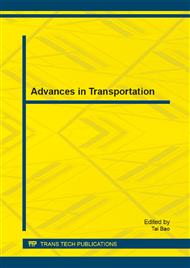p.1172
p.1179
p.1183
p.1189
p.1194
p.1199
p.1204
p.1211
p.1215
Study on Influencing Factors of Passenger Transfer and Transfer Volume in Comprehensive Passenger Transport Hub
Abstract:
Comprehensive passenger transport hub, the intersection of various means of transportation, its main function is to achieve "zero distance" transfer among different transportation means, meet travelers needs for efficient, safe, convenient and comfortable transfer, and maximize the services level of urban passenger transport. This paper conducts a research on influencing factors of passenger transfer in comprehensive passenger transport hub and the transfer volume of different transportation means. The result not only provides technical support for design of comprehensive passenger transport hub in future, but also shows application value in optimizing facilities of hub, and improving pedestrian traffic and self-organization science.
Info:
Periodical:
Pages:
1194-1198
Citation:
Online since:
January 2014
Authors:
Price:
Сopyright:
© 2014 Trans Tech Publications Ltd. All Rights Reserved
Share:
Citation:


